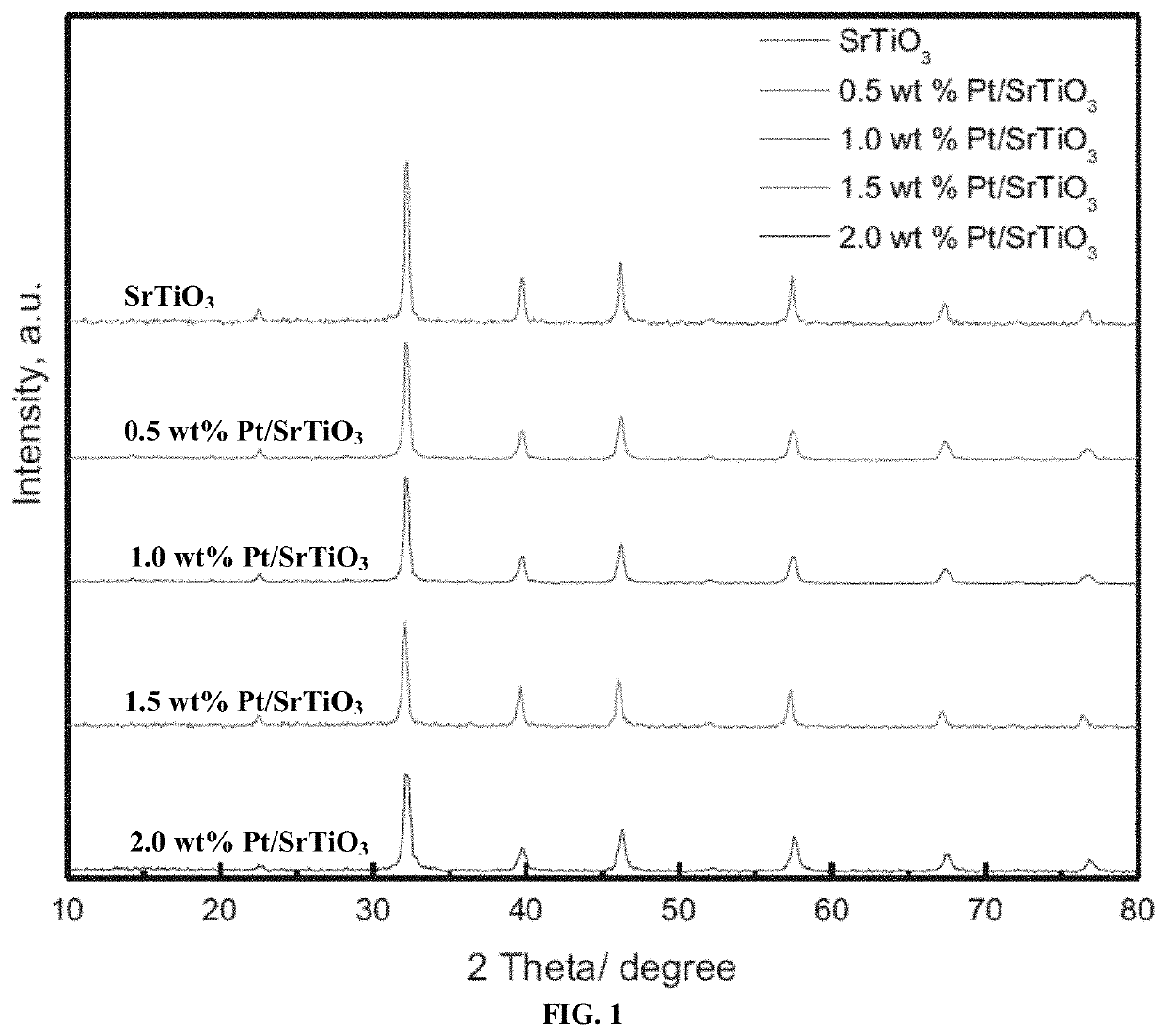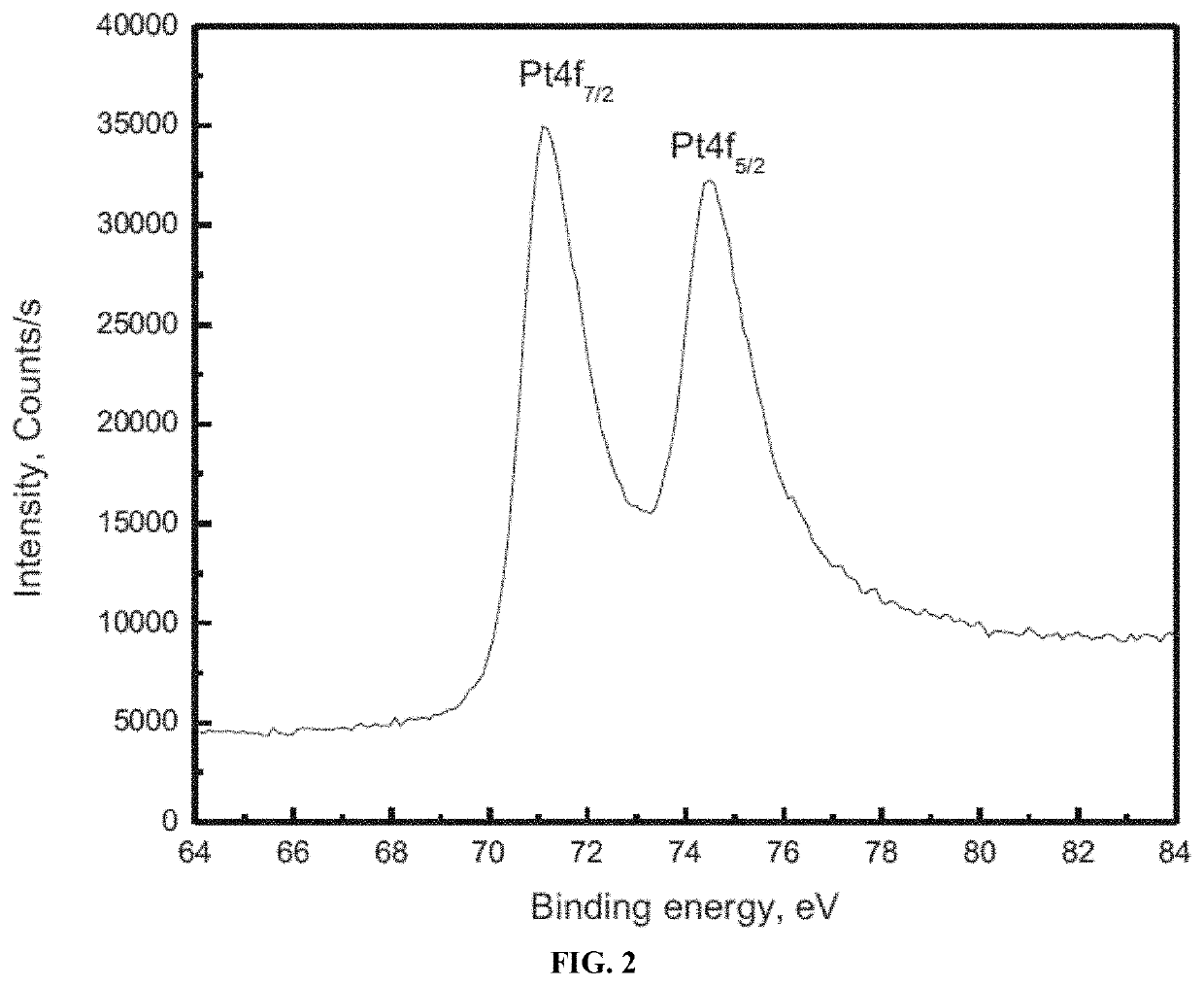Process for forming a photocatalyst and oxidizing a cycloalkane
a photocatalyst and cycloalkane technology, applied in the field of process for forming a photocatalyst and oxidizing a cycloalkane, can solve the problems of reducing the recovery/separation step, reducing the production yield, and limited amount of research devoted to selective oxidation of cyclohexan
- Summary
- Abstract
- Description
- Claims
- Application Information
AI Technical Summary
Problems solved by technology
Method used
Image
Examples
example 1
Photocatalyst Preparation
[0081]Strontium titanate (SrTiO3) nanoparticles were prepared by an ultrasonic method. 0.3 mole of strontium acetate was added under a nitrogen atmosphere to 16 mol glacial acetic acid and stirred for 2 h at room temperature. Then, 5 mol titanium isopropoxide was added to the solution mentioned above and the resulting mixture was stirred at room temperature for 6 h. Then, 20 mL of acetone was added and the resulting mixture was put in an apparatus for low-frequency ultrasound (Bransonic 42 kHz) for 1 h. The resulting material was dried at 100° C. for 24 h. then calcined at 550° C. for 5 h in air. A photo-assisted deposition (PAD) route was used to prepare Pt / SrTiO3 photocatalysts which contain different wt % of Pt metal (0.5, 1.0, 1.5 and 2.0 wt %). In this route, Pt metal was deposited on SrTiO3 nanoparticles using an aqueous solution of platinum chloride while applying UV light irradiation. The obtained samples were dried at 60° C. for 24 h and treated wit...
example 2
Photocatalyst Characterization
[0082]The crystalline phase of the strontium titanate (SrTiO3) nanoparticles and Pt / SrTiO3 photocatalysts was determined using powder X-ray diffraction (XRD) (Bruker axis D8 instrument) using CuKα radiation (λ=1.540 Å) in the 2θ range from 10° to 80° at room temperature. The chemical state information of the photocatalysts was determined using X-ray photoelectron spectroscopy (XPS) (Thermo Scientific K-ALPHA spectrometer). The morphological structure of the strontium titanate (SrTiO3) nanoparticles and Pt / SrTiO3 photocatalysts was examined using a transmission electron microscope (TEM) (JEOL-JEM-1230). Specimens for TEM analysis were prepared by dispersing the nanoparticles in ethanol and placing one drop onto a holey-carbon-coated copper supported grid. The specific surface area was determined from nitrogen adsorption / desorption isotherms which were measured at 77 K using a Nova 2000 series Chromatech. Prior to the analysis, the samples were outgassed ...
example 3
Characterization of Strontium Titanate Nanoparticles and Pt / SrTiO3 Photocatalysts
[0083]FIG. 1 illustrates XRD patterns of the strontium titanate (SrTiO3) nanoparticles and Pt / SrTiO3 photocatalysts. The obtained XRD patterns of the strontium titanate (SrTiO3) nanoparticles and Pt / SrTiO3 photocatalysts reveal characteristic peaks of SrTiO3, suggesting that doping strontium titanate nanoparticles with Pt does not significantly affect their structure. Furthermore, the characteristic XRD peaks of platinum or platinum oxide were not detected, which could be attributed to the fact that the weight percent platinum was lower than the detection limit and / or good dispersion of Pt on the SrTiO3 nanoparticles surface was achieved. The same phenomenon was observed when oxomolybdate species dispersed over TiO2 which was used for direct methanol oxidation [Faye J, Capron M, Takahashi A, Paul S, Katryniok B, Fujitani T and Dumeignil F 2015 Effect of dispersion on to dimethoxymethane over MoOx / TiO2 E...
PUM
| Property | Measurement | Unit |
|---|---|---|
| pressure | aaaaa | aaaaa |
| temperature | aaaaa | aaaaa |
| crystallite size | aaaaa | aaaaa |
Abstract
Description
Claims
Application Information
 Login to view more
Login to view more - R&D Engineer
- R&D Manager
- IP Professional
- Industry Leading Data Capabilities
- Powerful AI technology
- Patent DNA Extraction
Browse by: Latest US Patents, China's latest patents, Technical Efficacy Thesaurus, Application Domain, Technology Topic.
© 2024 PatSnap. All rights reserved.Legal|Privacy policy|Modern Slavery Act Transparency Statement|Sitemap



